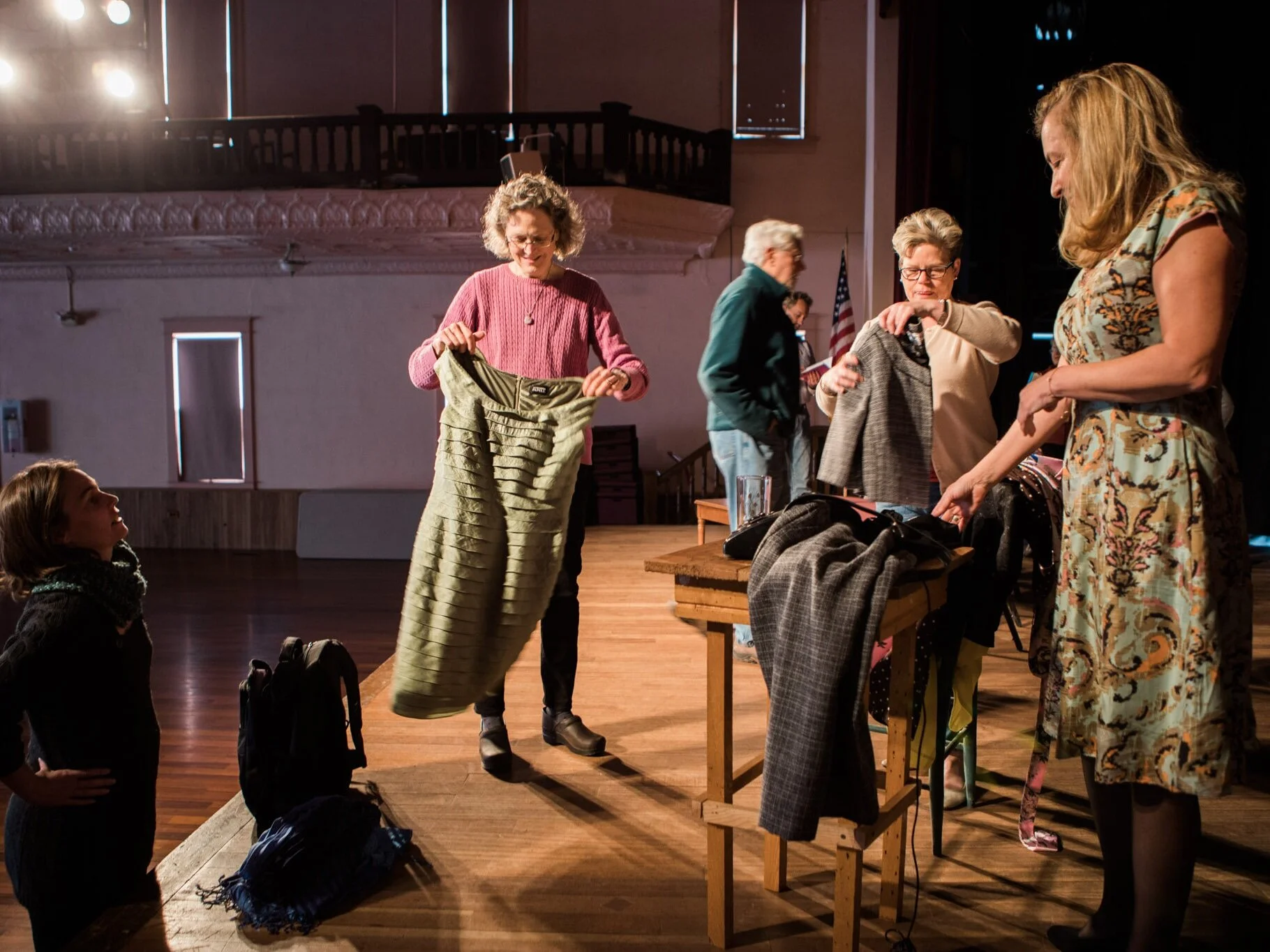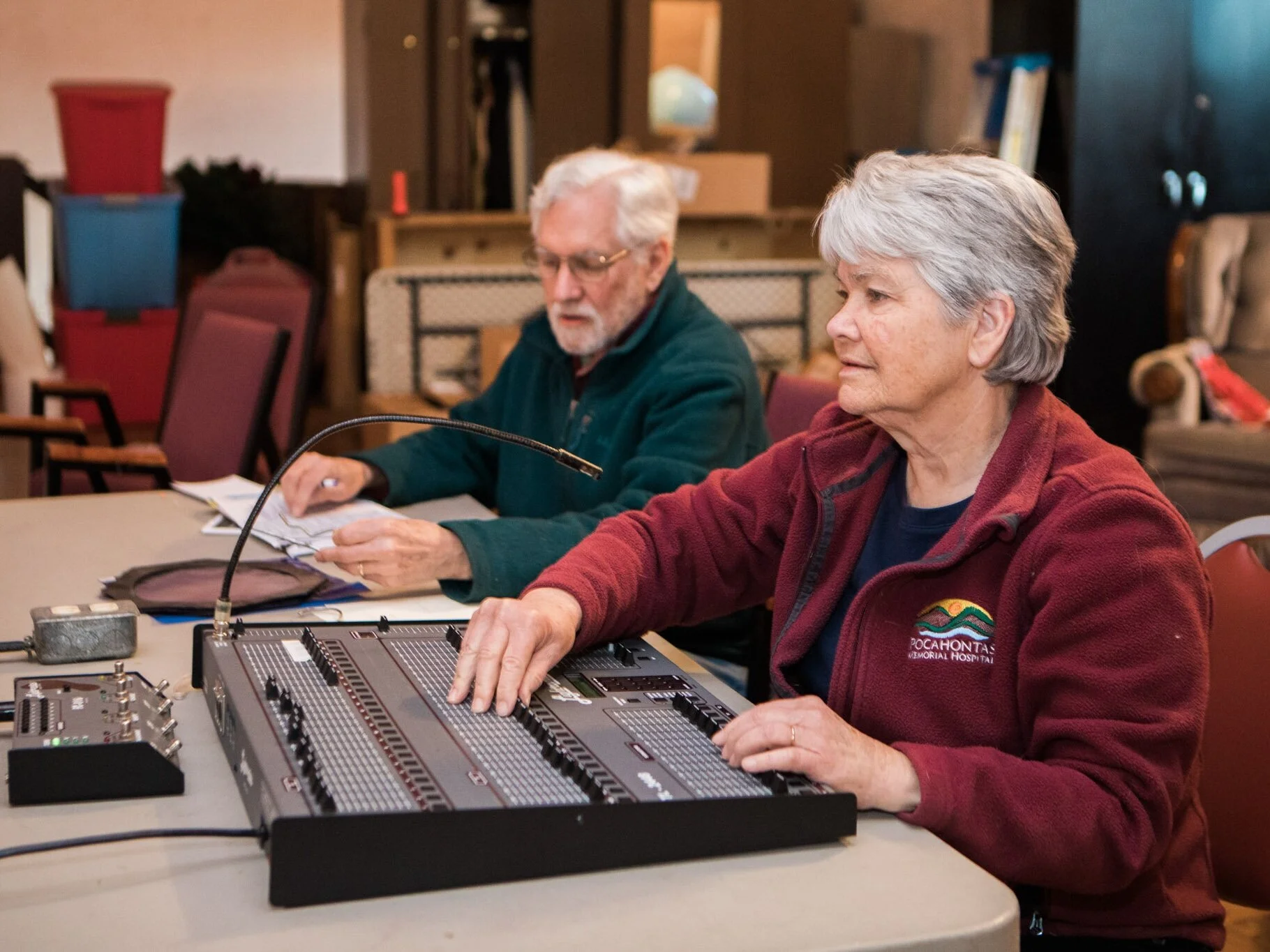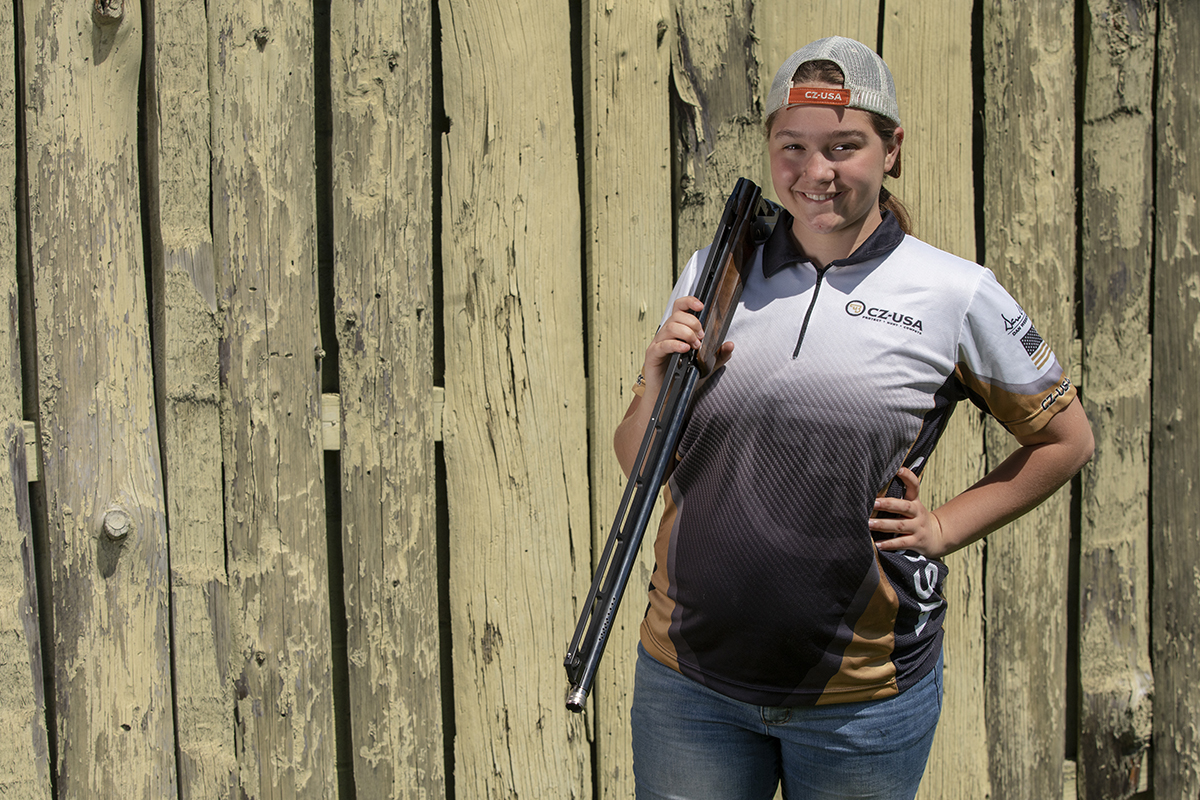A Peek Behind The Curtain

BY BARBARA ELLIOTT
pictures by Sheena Pendley
There’s a wonderful scene in Shakespeare in Love when theatrical entrepreneur Philip Henslowe explains to a stage-struck fellow how theater works. It goes like this:
Philip Henslowe:
Mr. Fennyman, allow me to explain about the theatre business. The natural condition is one of insurmountable obstacles on the road to imminent disaster.
Hugh Fennyman:
So what do we do?
Philip Henslowe:
Nothing. Strangely enough, it all turns out well.
Hugh Fennyman:
How?
Philip Henslowe:
I don’t know. It’s a mystery.
That little scenario pretty much sums up the story of the Pocahontas County Drama Workshop, a decidedly informal outfit that for more than 25 years has been mounting productions that give a whole new meaning to the term community theater. That is, until this year, when disaster proved more than eminent as the Covid-19 pandemic struck just as rehearsals began for Never Too Late, which was scheduled for a run in May.
The longevity of the enterprise is due largely to a dedicated core group that has persevered through enough obstacles and imminent disasters to daunt most mortals. Since 1993, writer/director/actor Margaret Baker has been at the helm, ably assisted by the husband and wife team of Janet and Frank Ghigo on sound and lights. Other stalwarts are set and graphic designer Susan Chappell and Jane-of-all-trades Huppert, who does pretty much everything else. When Baker had to bow out for several years when she accepted a full-time teaching job, guest directors Eric Fritzius, Arla Ralston and Charlie MaGhee Hughes stepped in so that the shows could go on.
“It’s the most informal group of people who somehow get things done,” Baker says. “Janet Ghigo claims we have always functioned best as an anarchy.” There are no bylaws and absolutely no Roberts Rules of Order. The Ghigos and Baker are the most consistent “members.” The only predictable income is from Pocahontas County Dramas, Fairs and Festivals, which pays a small stipend for the director. The rest of the miniscule budget comes from the box office. Except for the director, everyone is a volunteer.
“We only have one meeting a year, after they play,” Baker explains. “It’s usually just Frank, Janet, Jane and me. Sometimes others drift in and out. If you come to the meeting you get a say so. We have dinner in Marlinton, decide on how much to hold back for the start-up budget for next year, then we give the rest away to organizations that support us like the Pocahontas County Opera House, the library and the community radio station.”
Early Days
The Pocahontas County Drama Workshop evolved from a couple of historical dramas that were produced by Pocahontas County residents in the early 1990s. Cass, written by Pocahontas County resident Niki Maleckar, told the story of the town’s history during the lumber boom and was performed at locations in and around Cass. The second, a musical about the life of Hillsboro native Pearl S. Buck by West Virginia playwright Jean Battlo, was presented at the Pearl Buck birthplace. Some of the movers and shakers of that effort, including the Ghigos (Janet played the adult Pearl), started to mount other productions wherever they could find a space to perform. Maleckar and Lou Macknik directed several of those early productions.
Things became a little more consistent when Margaret Baker moved to Hillsboro from Philadelphia, where she had been writing and performing one-woman shows. Her master’s degree in acting and directing qualified her to be named the county’s Artist-in-Residence in 1993. Through a state-funded program, she received a stipend to do drama workshops with kids in the schools and direct one community play a year.
She soon discovered that her role as director not only included selecting a play and finding a cast, but also recruiting volunteers to design and build sets, run lights and sound, design programs and posters and man the box office. In a county that is 100 miles long with fewer than 10,000 people, that’s a pretty big order. In addition to directing, for many years Baker also did the publicity and even brought in her rubber gloves the night before a performance to clean the bathrooms.
Perils of Picking the Play
For Baker, selecting the plays is always stressful. “I can’t just do a play I like. For example, we don’t have a great deal of minorities in Pocahontas County. The cast can’t be too big because with too many people, it’s hard to work around their schedules.” Other considerations include the men/women ratio (especially where to find the men) and whether she can find actors with the chops to handle the subtleties of a more complex play. Big dance numbers are out (as are musicals in general), and she steers clear of technical nightmares.
Increasingly, the challenge is to find a play that is acceptable to the community, yet isn’t too dated. Baker notes than many contemporary plays contain sexual content and strong language. She took a risk a few years back with Proof, a Pulitzer- and Tony-winning play sprinkled with F-bombs. She says it was one of the most artistically rewarding productions she has directed. Still, because of warnings in all the publicity that the content was for mature audiences, attendance was down.
“On the other hand, if you go back to the 60s, there is real sexist kind of stuff,” she remarks. Never Too Late, falls more in that category, but she is approaching it as a period piece rather than trying to update to make it more politically correct.
In 2015, Arla Ralston, who had moved to Pocahontas County from Charleston, took over directing duties when Baker stepped aside for her teaching job. Ralston had extensive experience with the Charleston Stage Company, Kanawha Players and Shakespeare Studio, but she soon realized she was working in a totally different world. “Coming from Charleston, I was used to having a pretty big field of actors to choose from. You’d hold auditions and the problem would be deciding who got what part. For my directing debut, I picked Sherlock Holmes: The Final Adventure, a fun fast-paced play with nine characters—six of them men. I ended up chasing down guys all over the county to cast the play,” she remembers.
When Greenbrier Valley Theatre veteran writer/actor/director Eric Fritzius came on board the following year, he chose to direct a series of short plays. “It was daunting to consider because, while I had not seen any of the previous productions, I had known of Margaret for several years and had heard legends of the shows she had written and directed there. My major goal on being hired was to not burn the place down in her absence,” he says. “Margaret suggested I direct something I’d written, as she had in the past. I didn’t have anything full length ready to go, though, and tend to write mostly short plays myself. And since most of what I had directed previously had been for short play festivals, I decided such a festival would be a good start. They’re fun to do because you can fit a lot of different styles of theatre into an evening.”
Fritzius returned for another two seasons, but was not able to direct the 2019 production. “I was thrilled to learn that Charlie Hughes, a cast member in my productions and the director of the Opera House’s after school theater program, would be directing. She’s a talented actor and one of my favorite human beings up there, so I knew the show would be in good hands, Fritzius says. Hughes selected the all-woman comedy/drama Steel Magnolias, which was a tremendous success.
Casting Call
Imagine you’re the director of a play and one of the following things happens. An actor skips two pages of dialogue so the sound of the car crash comes after the characters talk about the car crash. An actor confides that he could be arrested at any moment. An actor exits through the fake door of a refrigerator on the set. An actor announces that he is hearing voices in his head. An actor passes a kidney stone in the middle of a scene. All these and more have happened to Baker over the years. At least the kidney stone guy was playing a dead person and was lying on the floor under a sheet when the stone passed. He toughed it out until the scene ended, then headed to the ER.
Finding a cast in Pocahontas County is a bit like a scavenger hunt. “I’m not too proud to pull up next to someone and say, hey, would you like to be in a play?’” Baker says. “I have somewhat of an instinct about who will be good. It may be their ease of movement that gives me a clue. Unfortunately, I’m not that instinctive about who will be bad. Pretty much, if someone can read and gets that you have to stop at certain places, I can work with them. Maybe they won’t turn into Marlon Brando, but I can work them.”
What makes it all worthwhile is when she uncovers a raw talent and watches it grow. For The Foreigner, she needed someone who could do an accent. The Ghigos found Larry Morgan, who worked with Frank at the National Radio Astronomy Observatory and was British, and Baker reeled him in. “At first he was a bit stiff, but he really blossomed and went on to do another play. He was a real find. He also met his wife doing our play,” Baker comments.
Arla Ralston had a similar experience casting the Sherlock Holmes play. “Bob Martin, who played Moriarty, rushed back from the Rite Aid after the first audition to tell me he had recruited this guy to be in the play. It was Chris Curry, who was great and has gone on to do several other shows with the Drama Workshop. Of my cast of nine, only two had really been on stage before. Even the star—Sherlock Holmes—was played by a newbie, Clint Carte, who did a marvelous job,” she says.
It takes real commitment to be in a production. Actors often drive as much as an hour each way to rehearsals, which are typically held two nights a week from March through mid-May. “It’s a high wire act. There are no understudies. Sometimes the cast is inconsistent. I will make concessions for someone who is not as good as an actor, but will show up.” Baker remarks.
If they gave a prize for most performances in Drama Workshop productions, it would probably go to John Davis. A veteran of college and community theater before moving to Pocahontas County, he loves the camaraderie that develops through the rehearsal process. “It brings together a group of people who would not normally get together. There’s something about the cast of a play. You don’t have to be best friends, but in a play, you are able to work together to bring about the best result. You pull together to accomplish a common cause. You feed off each other when things are going well,” he says.
Location, Location
Until the Pocahontas County Opera House in Marlinton was renovated and became the company’s permanent home in 2001, productions were held in a variety of locations, including the Marlinton Municipal Building (above the fire station), the Pocahontas County Courthouse, the Country Roads Café (now the Pretty Penny) in Hillsboro, Marlinton Middle School, the Dumore Community Center and Marlinton’s Stillwell Park.
John Davis recalls when he was in Arsenic and Old Lace at the Municipal Building, the fire alarm went off in the middle of a scene. ”The sirens were screaming. We are not professionals, but every character froze where they were and just picked up their lines when the sirens stopped,” he says. He also recalls that during a performance of Harvey in the same space, a flat fell on the stage. “We had to stop and take care of that.”
Things have been a lot simpler since the Pocahontas County Opera House generously agreed to host the plays, but there are still challenges. Rehearsals have to be scheduled around times when the building isn’t being used for other performances or rentals. If the Opera House is really booked up, the actors rehearse wherever they can find a (free) available space. It is only during the two weeks leading up to the show that the Drama Workshop has access to the building to construct sets and leave all props in the wings between rehearsals.
Technical Support
When Arla Ralston agreed to direct, her biggest worry turned out to be the least of her problems. “I told Margaret that I had little background in technical theater, and managing the details of lighting and sound were terrifying to me,” she recalls. “Likewise finding a stage manager, prop, costume crew in Pocahontas County where I was a newcomer seemed impossible. She assured me that there was already a crew in place but I was dubious. Especially when she told me that the stage manager, prop and costume master were all one person—Jane Huppert. But she was right! I was so impressed with the level of talent and dedication of the crew with Frank and Janet Ghigo on sound and lights, and Jane taking on everything else, as well as holding my hand throughout, we managed to pull off a very complicated play.”
The Ghigos, who met while working on theater productions in college, have been with the Drama Workshop from the beginning. Janet has overseen the evolution of lighting design from the days when the workshop owned six lamps controlled on a board made by the high school using regular household dimmer switches. With the help of Galen Watts and Dan Pedtke, engineers at NRAO, they have gradually acquired more and better equipment. “With 12 lamps and an expanded dimmer board, we can do much more sophisticated lighting design, using colored gels to change mood or time of day, lighting only the part of the stage where there is action,” she explains.
Frank Ghigo took over from Galen Watts as the company’s sound and special effects man in 2009. “I think prior to The Foreigner in 2006, there were no sound effects other than music for pre-show and intermission, and when music was called for in the play. Before there was a sound system in the Opera House, we would have to lug in speakers and an amplifier if we needed music,” he recalls.
The directors all credit Jane Huppert with being the glue that holds the whole enterprise together. Since 2003 she has been assisting behind the scenes doing scene changes, managing the actors, providing props, doing sound effects, applying makeup, helping with wardrobe changes and prompting the actors. She attends rehearsals to help the director with blocking and has occasionally designed sets and is usually involved with building them.
Huppert also has been the costumer for many shows and is famous for her ability to come up with props. She has an entire barn filled with stuff that might someday be called into service. Baker says she gives hoarding a good name. For example she had no trouble coming up with the toilet required for Never Too Late. “I always have my eyes searching for things when I visit thrift stores, flea markets, yard sales and, of course, the green boxes. I take my creativity out of its box and let it run wild for three wonderful months,” she says.
Building a Set on $300 a Play
Sets for early productions were a somewhat iffy proposition. Things improved significantly when Susan Chappell joined the creative team. A talented artist, she has managed to design some inventive sets on a budget of around $300 per show. She also has designed many programs and posters. Although her background is in graphic design, Chappell says that when Baker asked her to design a set for The Importance of Being Ernest, she welcomed the challenge. At first, she simply drew sketches of the designs, but she has now built a model of the Opera House that she uses to create a three-dimensional rendering of each set.
“Because I had designed and built three or four homes, I have a spatial sense that’s helpful. I am a minimalist set designer,” Chappell notes. “It’s a small theater, and we have a ‘beg, borrow or steal’ mindset. You have to build the simplest set you can, and you have a limited crew to build it.”
For a number of years, they were able to borrow flats and set pieces from the Drama Department at the high school, but that is now defunct, so they are on their own. “I’m very good at coming up with something out of nothing,” Chappell says. One set she particularly enjoyed was for Moon Over the Brewery. “We borrowed stairs and a platform from the school and built onto them,” she explains. “One of the main reasons to do that in a repeating triangular design was to hang paintings on it. All of my wonderful artist friends did paintings of moons. It was great fun.”
The Sherlock Holmes play presented a real challenge, in that there were four distinct scenes. “We didn’t have the resources or space to do big scene changes, so we built a kind of inverted periaktos,” she says. That ancient theatrical device involves building a triangular structure of wooden panels that can be rotated on rollers to created different backgrounds.
“Susan’s sets are minimal, but look great. She works with lighting and very few furniture changes to create a new scene. She really takes pride in it. If her name is on it, it will look good,” Baker notes.
For Never Too Late, Chappell was helping two other volunteers, Cristin Bartlett and Sue Gauntt, learn the set design ropes. Her biggest challenge—to construct a bathtub that looks real enough and is sturdy enough for a person to get into, but will not destroy the backs of the actors who have to lug it on stage.
Another (Delayed) Opening, Another Show
Retired from teaching, Baker had re-joined the team and was set to direct this year’s production of Never Too Late, a Broadway hit from the early 1960s. The cast featured the usual mix of newcomers (Dawn Barrett, Laura Dean Bennett, Will Armentrout, Dave Bethany) and seasoned performers (David Fleming, Rachel Fanning, Jay Miller). Leslie McLaughlin, who signed on as the costume designer for Steel Magnolias last year, was having a blast finding vintage dresses and accessories. Then Covid-19 shut them down.
Will they eventually be able to pull off this production despite a world-wide pandemic? If it can be done, this bunch will do it. Baker, the cast and crew are committed to trying again in May of 2021. After all, it’s never too late.






